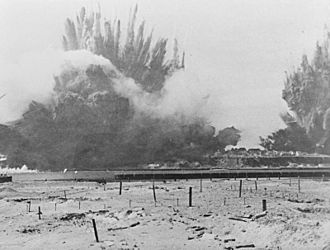Operation Big Bang facts for kids
Operation Big Bang, also known as British Bang, was a massive explosion that destroyed military buildings on the island of Heligoland. On April 18, 1947, the Royal Navy used 7,400 tons (6,700 metric tons) of leftover World War II ammunition. This huge amount of explosives was placed around the island and set off at 1 p.m.
The explosion was incredibly powerful. It released energy equal to about 3.2 kilotons of TNT equivalent. This made it the biggest artificial non-nuclear explosion at that time. The main goal was to destroy old bunkers and military sites on the North Sea island. Some people even thought the whole island might disappear! However, the island's soft sandstone allowed the blast wave to escape. Only the southern tip was destroyed, but the northern tip also suffered a lot of damage.
What Was Heligoland's History?
Heligoland is located in the middle of the German Bight. This area is near important rivers like the Weser and the Elbe, and the Kiel Canal. Because of its key location, the waters around Heligoland were important for naval battles. Four major sea battles happened here between 1849 and 1917.
In 1807, the United Kingdom took control of the island from Denmark. Later, in 1890, Germany traded some land in Africa for Heligoland. This deal was called the Heligoland–Zanzibar Treaty. Germany wanted to turn the island into a strong naval base. After World War I, the Treaty of Versailles said that Heligoland's military buildings had to be destroyed. This work happened from 1920 to 1922, but not everything was completely removed.
During the Nazi period (1938), Germany started a project called "Project Lobster Claw." The idea was to make Heligoland a powerful military base. This was meant to challenge the British naval base in Scapa Flow. However, this project was never finished. After World War II, the British took control of Heligoland. They used it as a training and blasting area from 1945 to 1952.
How Did the Explosion Happen?
In April 1945, the Royal Air Force bombed Heligoland with about 1,000 planes. After this attack, the island's 2,500 people were moved away by the German army. On May 11, 1945, British forces took over the island.
The British decided to blow up the bunkers and military sites on Heligoland. This was to stop Germany from using the island as a naval base again. They filled the submarine bunker and underground tunnels with old ammunition from the world wars. The preparations took longer than expected, so the explosion was delayed.
On April 18, 1947, exactly two years after the bombing, the Royal Navy set off the bomb. They used thousands of torpedo heads, depth charges, and shells. British engineers on a ship called HMS Lasso triggered the blast from about 17 kilometers away. The British wanted the German public to see this event. Many journalists watched from a steamer ship. A smaller explosion was set off first to scare away birds. The main explosion happened a few minutes later.
A huge burst of fire and tons of rock shot into the sky. People could feel the ground shake 70 kilometers away in Cuxhaven. A giant mushroom cloud rose high into the air. The explosion shook the island's base deep underground.
What Happened After the Blast?
The island of Heligoland survived the massive explosion. However, the southern part of the island was blown away. The broken pieces of rock from this area now form a new part of the island called Mittelland. Some parts of the cliffs also fell apart, and many large holes, called craters, were created.
Despite the huge blast, the harbor buildings and walls that protect the coast remained mostly intact. The old civil air raid shelters also survived. Today, these shelters attract thousands of tourists every year. The only building that completely survived the explosion was the Flakturm, which is now the Heligoland Lighthouse.
Scientists in Germany were able to record the explosion using special equipment. They used this data to study the Earth's crust. In 1952, after many protests from the people who used to live there, the residents of Heligoland were allowed to return to their island. Today, on the anniversary of the explosion, people hold a special memorial service in the old civil defense bunker.




